How lucky am I? . . . Our neighbour Jane generously decided to share her fantastic gift of a trip to The Shard in London and afternoon tea with me – a great excuse to take a day off work . . . and Jane couldn’t have picked a better day in every respect – thank you!
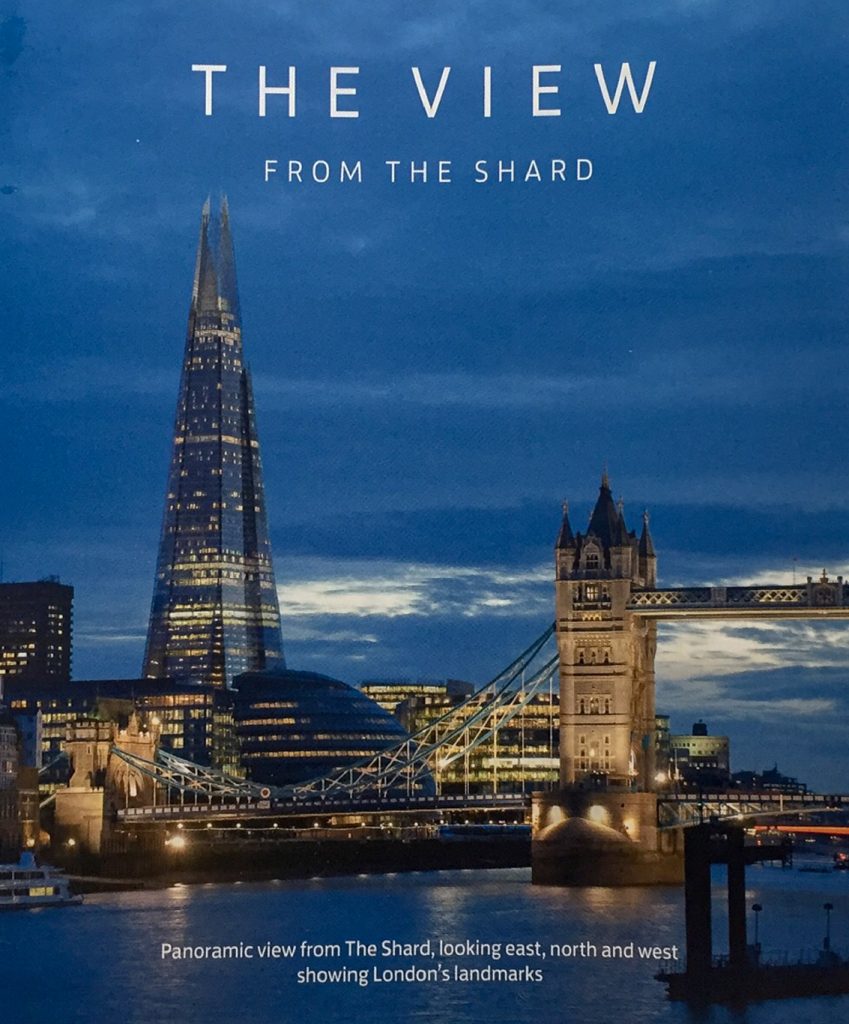
The glass sided pyramidal tower, the ‘The Shard’ or ‘The Shard of Glass’, is a 95-storey, 72 floor skyscraper rising 309.6 metres (1,016 ft) high, designed by Renzo Piano (an Italian architect), in Southwark, London. It is not only the tallest building in the United Kingdom but also in Europe. Today we’re going to visit the tower’s privately operated observation deck, ‘The View from The Shard’ which was opened to the public in 2013. On a price to height ratio the Shard is the most expensive skyscraper to visit in the world! But our trip up to the viewing platform was for later in the day! First, time for refreshments.

Borough Market is close by and was just opening up. We spotted this cafe, ‘Rabot 1745’ . . . imagine the smell of melted chocolate filling your nostrils . . . together with the myriad choices of merchandise and information on the production of chocolate right from its origin as a bean it seemed like a good place to start our London experience!
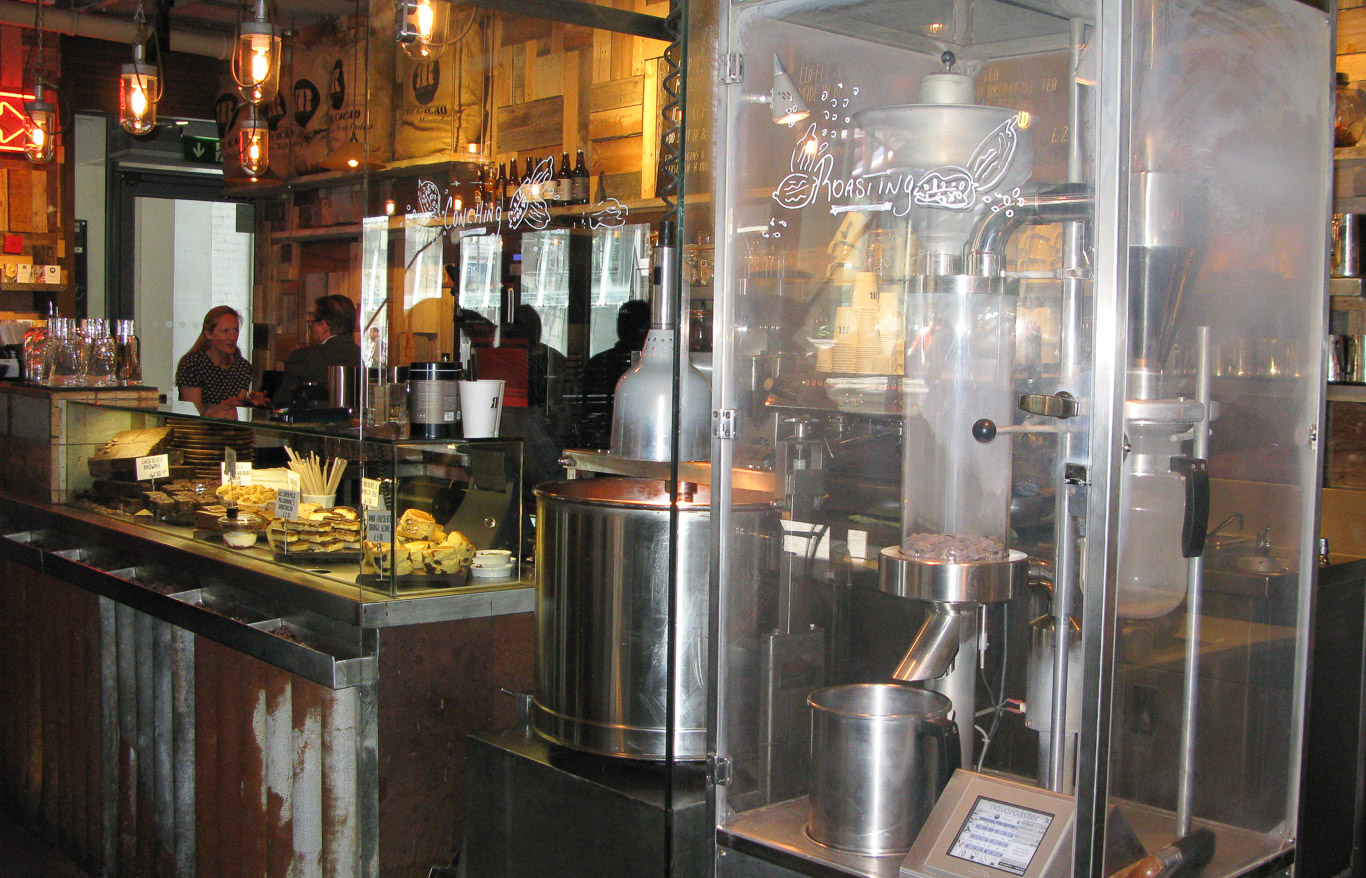
. . . so much to choose from . . .

Mmh . . .what to choose . . my mouth was watering in anticipation!
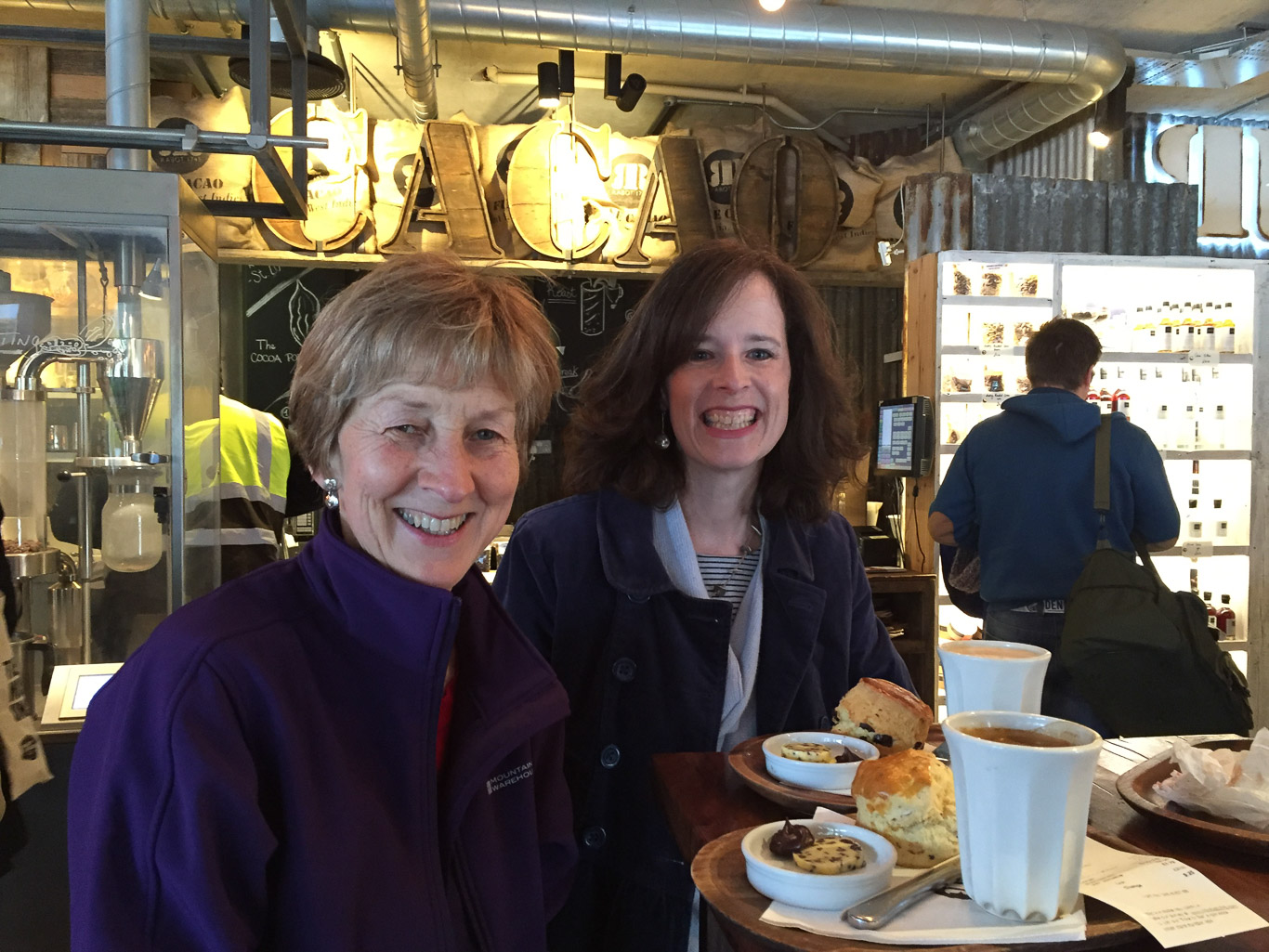
Finally, our choices made, coffee with chocolate and orange scones . . . served with melted chocolate and butter with chocolate nibs for both of us. . . Feeling refreshed, it was then time to do a bit of exploring around Borough Market.

Borough Market on Southwark Street and Borough High Street is an impressive place to visit and even better being there early thus avoiding the crowds of tourists who will arrive in the next couple of hours. It is one of the largest and oldest food markets in London dating back to at least the 12th century.

. . . whether you’re after seafood . . .

. . . a particular variety of tomatoes or . . .

. . . whatever you’re looking for food wise, you can probably find it here.

Perhaps some fungi . . . ?

. . . or maybe a tasty lunch of paella . . .
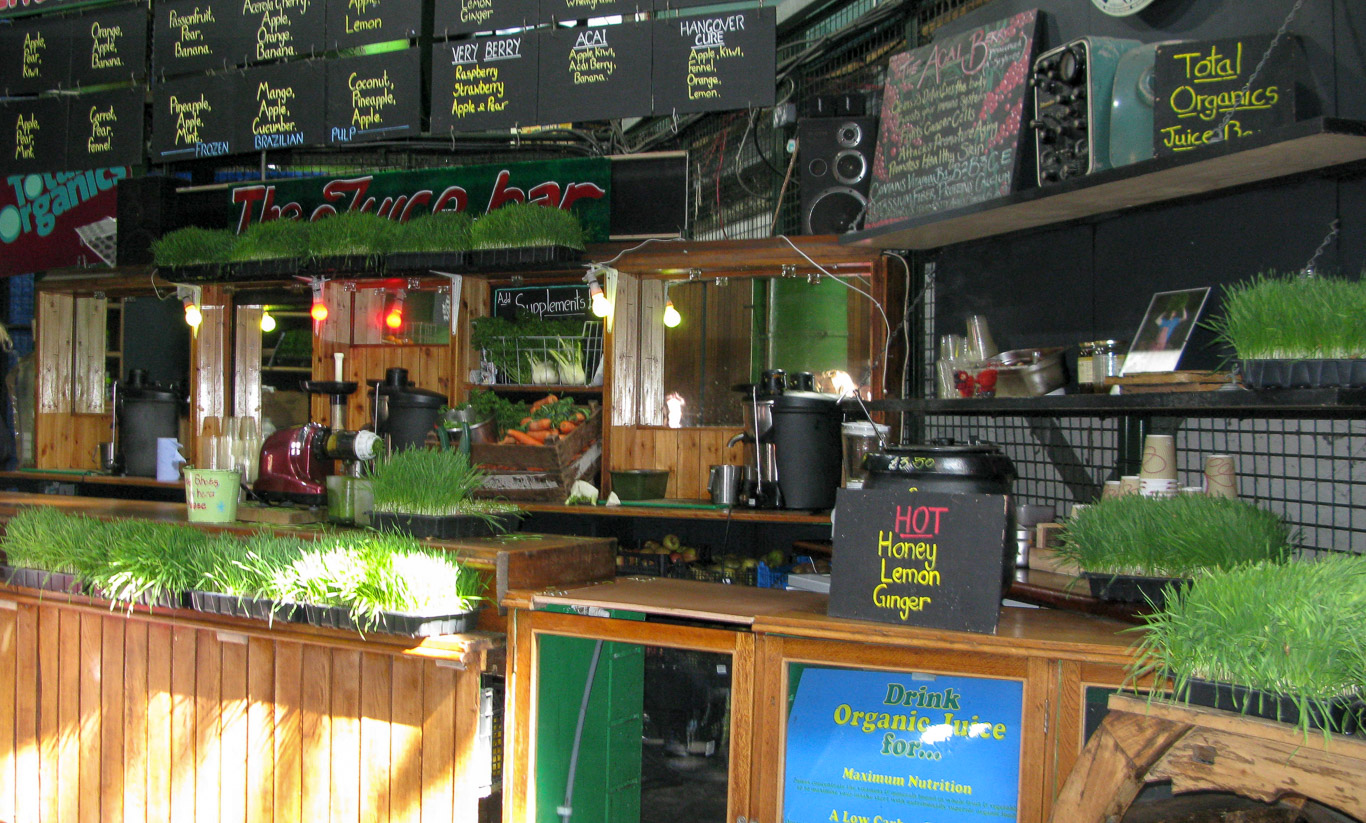
. . . or something more exotic!
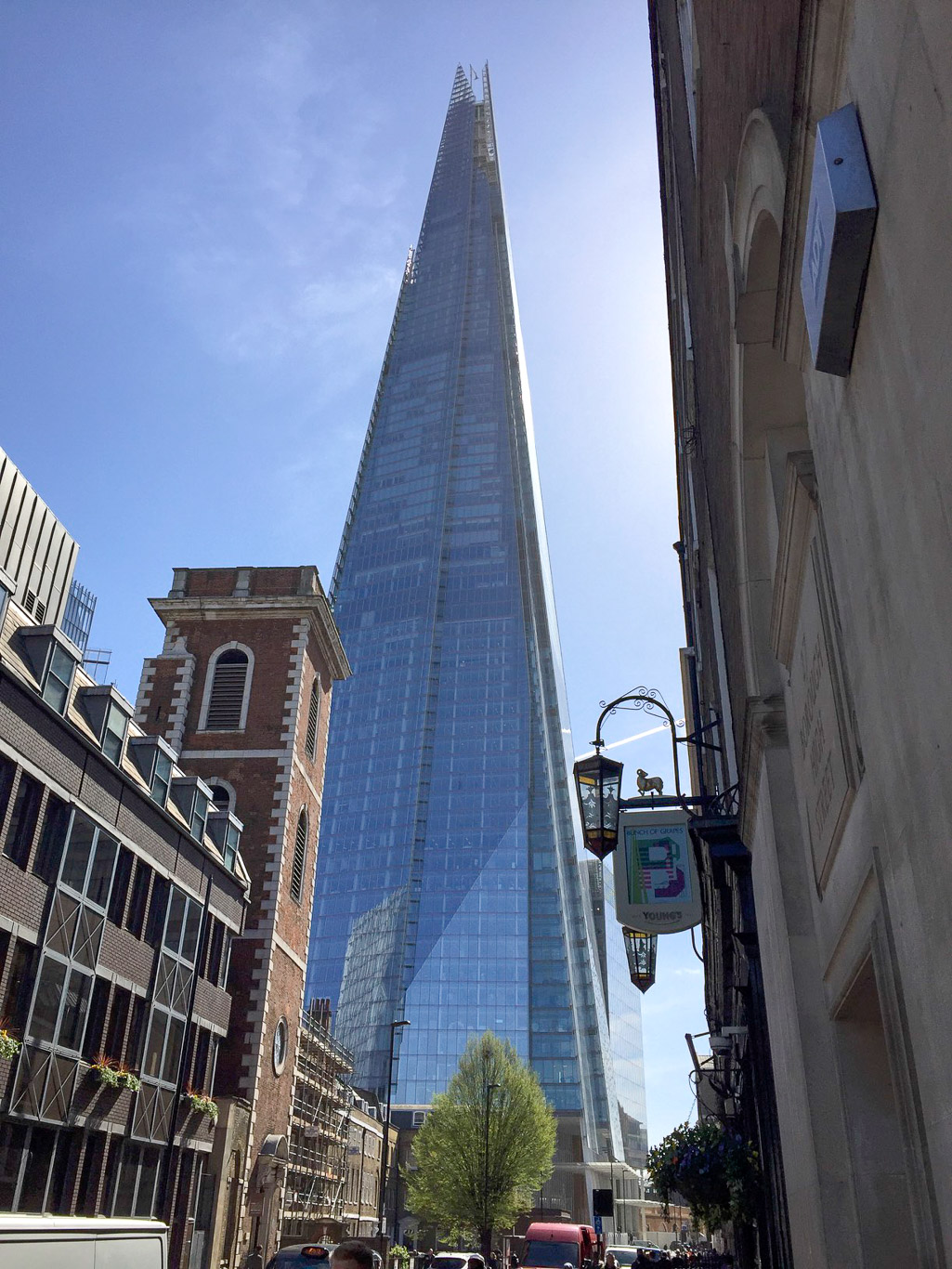
Now time to head for the main objective of our day . . . The Shard rises up like huge shards of glass almost supernaturally, seeming at odds with its more traditional surroundings.
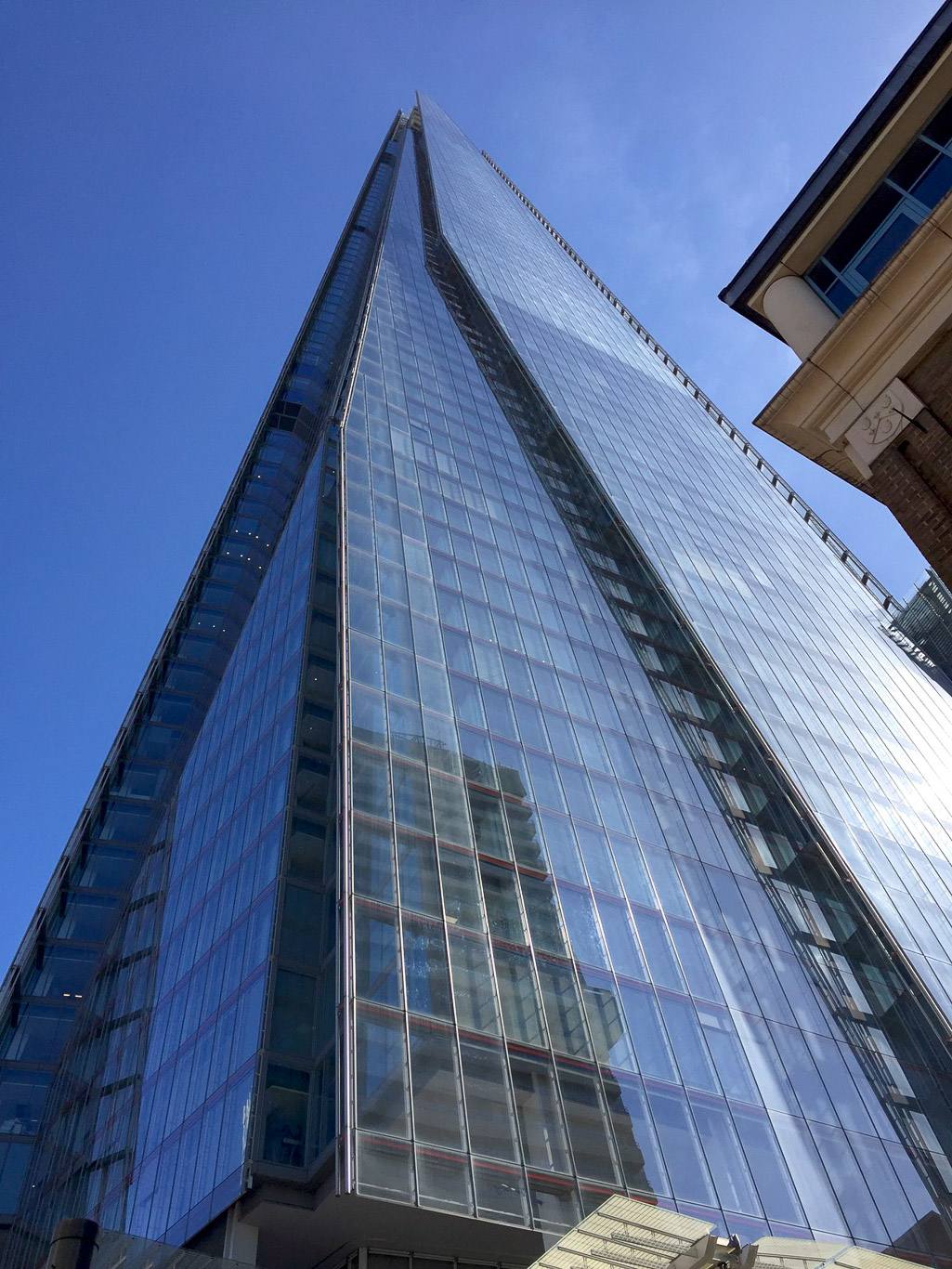
It’s easy to navigate to, soaring as it does above nearby buildings . . . I think it would be hard not to be impressed by its magnitude. Jane couldn’t have chosen a better day – look at the sky – we’re going to get amazing views.

From beneath you can barely see the summit of the structure as it stretches ever upwards . . .

A lift quickly brings you up to the viewing platform on the 72nd floor observation deck, 244m (802ft) up. . . . you can even purchase champagne up here! Being early it was quite quiet and therefore we could get clear, uninterrupted 360 degree views.
The information about the views comes mainly from Wikipedia.

Time to get our cameras to the ready . . .

. . . Smile . . .

More photos . . .

Where to look first?

The number of visitors is limited so you can really appreciate the expansive views.

Truly spectacular views . . . here looking north across the River Thames, you have the black skyscraper, Tower 42 (the fifth tallest building in the City of London), originally called the National Westminster Tower, because it was built to house NatWest’s international headquarters though now it has many different offices within it. From above the tower resembles the NatWest logo of three chevrons in an hexagonal arrangement!
To the right of Tower 42 is Heron Tower, officially called 110 Bishopsgate (completed in 2011). It is the tallest building (230m/755ft) in the City of London financial district and the 3rd tallest in the UK (after The Shard and One Canada Square). The design was controversial because of its proximity to St Paul’s Cathedral. An interesting fact is that in its lobby it has the largest (70,000 litre) privately owned aquarium in the UK. It has a number of restaurants one being the ‘sky bar’ accessed by scenic lifts.
In front of Heron Tower is the highly controversial 20 Frenchurch Street, nicknamed ‘The Walkie-Talkie’. Completed in 2014 with the three-floor ‘sky garden’ opening in 2015. It is controversial because of its proximity to St Paul’s Cathedral and because during its construction it was discovered that for up to two hours every day, if the sun shines directly on the building, it acts as a concave mirror and focuses light onto the streets to the south resulting in spot temperatures up to 91 degrees celsius. During the summer of 2013, the reflection from the building resulted in damage to parked vehicles and was so intense that a reporter managed to fry an egg in a pan set out on the ground thus the media dubbed the building the ‘Walkie-Scorchie’ and ‘Fryscraper’. According to the planners the ‘Sky Garden’ was to be a large, free public space at the top of the building with spectacular views of London including a glade of full-height trees, instead it has a slope with ferns and succulents and is only open to the general public for one half-hour slot which must be booked three days in advance! Can there be more criticisms – incredibly there are – it also produces a wind tunnel effect creating an unexpected impact on wind strength at street-level!
To the right is 30 St Mary Axe, nicknamed The Gherkin – it does look like a gherkin doesn’t it. Opened in 2004 it stands on the former site of the Baltic Exchange (damaged extensively in 1992 by a Provisional IRA bomb) and Chamber of Shipping. It was designed by Norman Foster and Arup Group. The tower’s topmost panoramic dome, the ‘lens’, recalls the glass dome that covered part of the ground floor of the Baltic Exchange. There are many energy-saving features in its construction.
Immediately to the right of The Gherkin is Lloyd’s Building nicknamed The Inside-Out Building – designed by Richard Rogers and Partners (completed in 1986), home to the insurance institution Lloyd’s of London. It has survived multiple scandals over the years. It’s nickname reflects the radical Bowellism architecture in which the services for the building, such as ducts and lifts, are located on the exterior to maximise space in the interior.
Custom House, City of London is the long white building with the distinctive blue railings on the north bank of the Thames used by Her Majesty’s Revenue and Customs though the government has announced that it is to be closed and sold off in 2020. A custom house has been in the area since the 14th century! With the growth of trade, the opening of the docks and the increases in duties during the Napoleonic wars, larger premises became necessary in the early nineteenth century which resulted in this present building.
Further along the Thames bank is the Tower of London an historic castle founded in 1066 as part of the Norman Conquest of England. Separated from the City of London by the open space known as Tower Hill, the castle was used among other things, as a prison from 1100 until 1952 – the infamous Kray twins (London gangsters heading organised crime in the East End of London in the 1950s and 1960s) were the last people to be held in the Tower. They were imprisoned for a few days in 1952 for failing to report for national service. The last state prisoner to be held in the Tower was Rudolf Hess, the deputy leader of the Nazi Party, in May 1941. The peak period of the castle’s use as a prison was the 16th and 17th centuries with the imprisonment of such people as Elizabeth I before she became queen; Sir Walter Raleigh and Elizabeth Throckmorton (Raleigh’s wife). Though seven executions were carried out within the Tower in the 20th century before the World Wars, most executions were held at the notorious Tower Hill to the north of the castle. As a whole, the Tower is a complex of several buildings set within two concentric rings of defensive walls and a moat. The Tower of London has played a prominent role in English history and controlling it has been important to controlling the country. It has at different times been an armoury, a treasury, a menagerie, the home of the Royal Mint, a public record office and the home of the Crown Jewels of England. At least six ravens are kept at the Tower at all times because of the myth that if they are absent the kingdom will fall!

A close-up of some of the highest skyscrapers in London.

Looking north east you can again see the Tower of London but now you can also see the famous Tower Bridge and the financial centre of Canary Wharf (the dark skyscrapers) in the distance.

Zooming in to the incredible views along the River Thames there’s Tower Bridge with St Katharine Docks on the far left barely in view. Tower Bridge is described by Wikipedia as being a combined bascule and suspension bridge built between 1886 and 1894. It is sometimes confused with London Bridge situated half a mile upstream (which is in fact a rather ordinary looking bridge). The bridge deck of the Tower Bridge is freely accessible to vehicles and pedestrians but the bridge’s twin towers, high-level walkways and Victorian engine rooms form part of the Tower Bridge Exhibition which has admission charges.
The skyscrapers in the distance are part of Canary Wharf, one of the main financial areas of London on the northern side of the Isle of Dogs with One Canada Square, is the second-tallest building in the Uk (containing fifty storeys), easy to distinguish with its sheer height and distinctive pyramid roof which contains a flashing aircraft warning light!
If you look carefully you can also see the Thames Barrier just as the river twists to the left. The barrier, one of the largest movable flood barriers in the world, is designed to prevent the floodplain of most of Greater London from being flooded by exceptionally high tides and storm surges moving up the North Sea. It’s been operational since 1982 and when needed it is raised from the river bed, closing part of the river during high tide and then opened, lowered, at low tide to restore the river’s flow towards the sea.
In front of Tower Bridge on the right shore is the circular building of City Hall, headquarters of the Greater London Authority, comprising the Mayor of London and the London Assembly designed by the famous architect Norman Foster.

A quick catch-up with Jane to talk about all the great London landmarks we can see . . . can you spot the one behind Jane’s shoulder on the right? . . . Yes, it’s St Paul’s Cathedral . . . but I’ll come to it later as I’m going round clockwise and St Paul’s is the view to the north west!
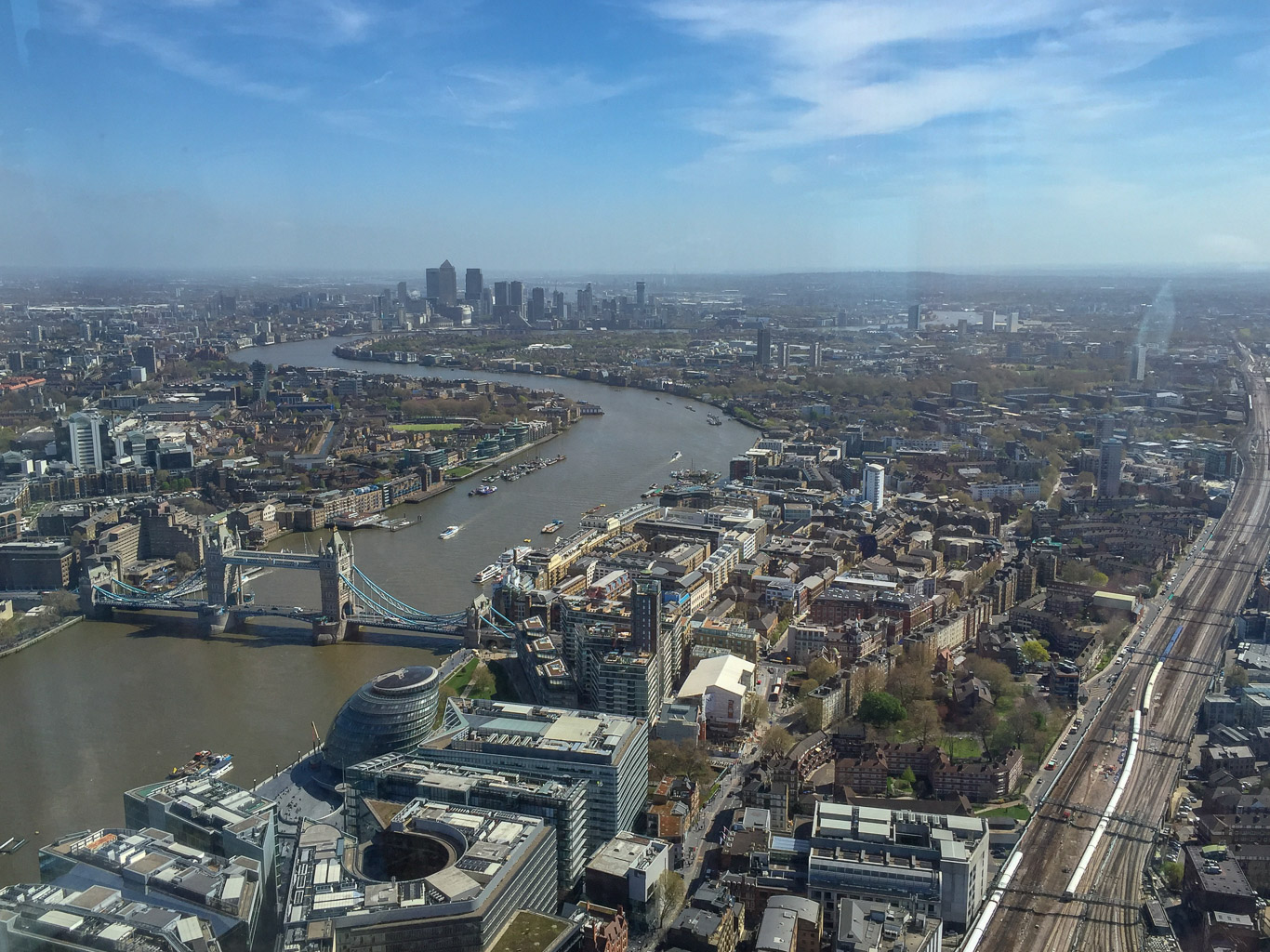
Looking east the new sights include ‘More London’ also named ‘London Bridge City’ (which includes the building at the bottom of the photograph with the circular hole at its centre). This is a development of 13 acres on the south bank of the River Thames immediately south-west of Tower Bridge owned by the Kuwaiti sovereign wealth fund. It includes the City Hall (the sphere shaped building immediately below Tower Bridge), a sunken amphitheatre called The Scoop as well as office blocks, shops, restaurants and cafes and a pedestrianised area containing open-air sculptures and fountains lit by coloured lights.
‘Butler’s Wharf’, which has the cream coloured roof just beyond Tower Bridge on the bank of the river is an historic building which now consists of luxury flats and restaurants though the term ‘Butler’s Wharf’ is also used to refer to the surrounding area. Butler’s Wharf was built between 1865-73 as a shipping wharf and warehouse complex accommodating goods uploaded from ships using the port of London. It is said to have contained the largest tea warehouse in the world. The building known as ‘Bulter’s Wharf was originally a chocolate biscuit factory . . . just what you need to go with a cup of tea!
On the right of the photograph you can see the London Bridge Railway lines.

Further east. There are no great landmarks here though Millwall Stadium (The Den) is just to the right of the railway lines as they curve out of the photograph though I can’t make it out!

Now we come to the view south. The tall building near the centre of the photograph is Strata SE1, nicknamed ‘Razor’ or ‘Electric Razor’, a 148 metre (486 ft) building at Elephant and Castle in Southwark completed in 2010. It is one of the tallest residential buildings in London with more than 1,000 residents living in 408 flats. Despite Strata SE1 being one of the first buildings in the world to incorporate wind turbines as part of its structure the three wind turbines are rarely used and in fact have not worked at all since 2010 – they were supposed to provide 8% of the energy needs of the building, sufficient to supply the building’s communal areas! It does however have provision for the collection of rainwater for re-use and the building is clad in a ‘bespoke high thermal performing facade’ – let’s hope that works better than the wind turbines!
Further to the left, near the horizon (just over a quarter of the way in from the left hand side of the photograph) you can just about see the white pillars of Battersea Power Station completed in 1955. It is a decommissioned coal-fired power station located on the south bank of the River Thames, in Nine Elms, Battersea and was given Grade II listed status in 1980. The station is one of the world’s largest brick buildings and notable for its original Art Deco interior fittings and decor. It is now owned by a consortium of Malaysian investors and includes 250 residential units, bars, restaurants, office space, shops and entertainment spaces.
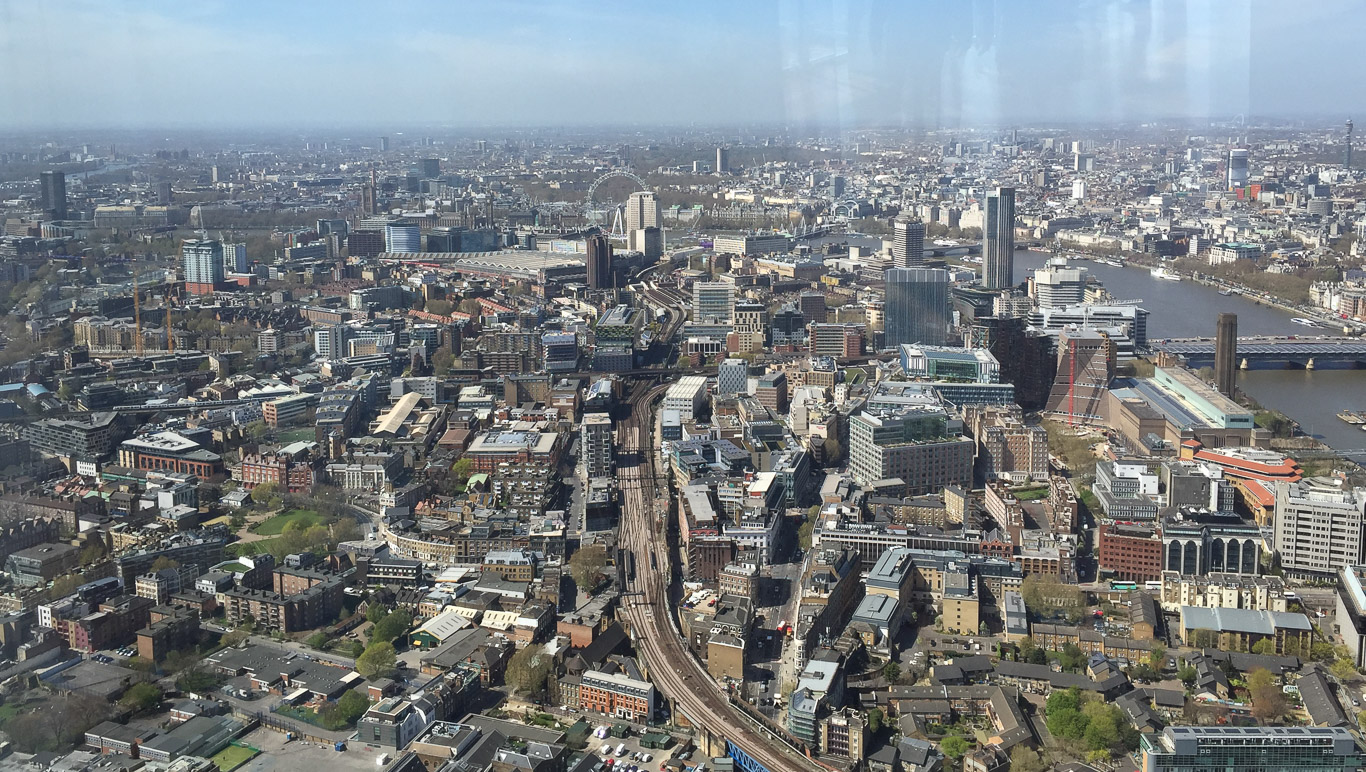
Please excuse the reflections in the glass! The photograph above is of the view looking south west with the most easily recognisable structure being The London Eye (just above the centre of the photograph). A tourist attraction that I still haven’t visited despite it being open to passengers in 2000 and being the most popular paid tourist attraction in the UK having more than 3.75 million visitors annually! It’s a huge ferris wheel, designed by Marls Barfield Architects and structurally engineered by Arup’s, and is Europe’s tallest cantilevered observation wheel. It is 135 metres (443 ft) tall and the wheel has a diameter of 120 metres (394 ft). Before The Shard was built The London Eye used to offer the highest public viewing point in London! The wheel has 32 sealed and air-conditioned passenger capsules (though numbered 1-33 – superstition meant that number 13 was omitted) and holds up to 25 people who are free to walk around inside the capsule, though seating is provided. Each of the 10-tonne capsules represents one of the London Boroughs. One revolution takes about 30 minutes as it only rotates at 26cm per second, slow enough to allow passengers to walk on and off at ground level without stopping.
The tiny white building to the left of The London Eye surrounded by greenery is Buckingham Palace – the London residence and administrative headquarters of the monarch since the accession of Queen Victoria in 1837 – or to put it simply – it’s where the Queen lives when she’s in London. It’s located in the City of Westminster and the palace is often at the centre of state occasions and royal hospitality. The palace has 775 rooms (imagine the fun you could have playing hide and seek – though perhaps you would never be found) – including 188 staff bedrooms; 92 offices, 78 bathrooms, 52 principal bedrooms and 19 state rooms. It also has a post office, cinema, swimming pool, doctor’s surgery and jeweller’s workshop. The garden is the largest private garden in London. The state rooms, used for official and state entertaining, are open to the public at various times throughout the year. Surprisingly when reading up about the palace I read that when Queen Victoria was widowed in 1861 the grief stricken Queen withdrew from public life and left Buckingham Palace to live at Windsor Castle, Balmoral Castle and Osborne House, leaving the palace to be seldom used and even neglected. In fact in 1864 there was a note pinned to the fence of Buckingham Palace saying, “These commanding premises to be let or sold, in consequence of the late occupant’s declining business.” Luckily public opinion eventually persuaded the Queen to return to London, though even then she preferred to live elsewhere whenever possible.
To the left of The London Eye, if you look extremely carefully is Big Ben (just above the white corrugated roof there’s a dark grey/black building (Westminster Palace) and Big Ben can be seen at it’s top right hand corner – I can see it when I zoom in on the original photograph though I’m not sure it’ll be discernible on the webpage). Big Ben is the nickname for the Great Bell of the clock at the north end of the Palace of Westminster and usually refers to both the clock and the clock tower. The official name of the tower in which Big Ben is located was originally the Clock Tower, but was renamed Elizabeth Tower in 2012 to mark the Diamond Jubilee of Elizabeth II. The tower was designed by Augustus Pugin in a neo-gothic style and when it was completed in 1859 its clock (built by Edward John Dent) was the largest and most accurate four-faced striking and chiming clock in the world. Big Ben is the largest of the tower’s five bells and weighs 13.7 tonnes. It was the largest bell in the United Kingdom for 23 years. The origin of the bell’s nickname is unclear – it may be named after Sir Benjamin Hall who oversaw its installation, or the heavyweight boxing champion Benjamin Caunt. In the lantern at the top of Elizabeth Tower is the Ayrton Light, which is lit when either House of Parliament is sitting after dark. It was installed in 1885 at the request of Queen Victoria – so that she could see from Buckingham Palace whether the members were “at work”. The tower is a British cultural icon recognised all over the world.
To the left of Big Ben is the Palace of Westminster, commonly known as the Houses of Parliament. It serves as the meeting place of the House of Commons and the House of Lords, the two houses of the Parliament of the UK. It’s name (Palace of Westminster) comes from the neighbouring Westminster Abbey. The palace is owned by the monarch in right of the Crown and for ceremonial purposes, retains its original status as a royal residence. The Palace of Westminster has three main towers, the largest and tallest is Victoria Tower which occupies the south-western corner of the Palace. At the base of the tower is the Sovereign’s Entrance, used by the monarch whenever entering the Palace to open Parliament or for other state occasions. The main body of Victoria Tower houses the three million documents of the Parliamentary Archives in 5.5 miles (8.8 km) of steel shelves spread over 12 floor. These include the master copies of all Acts of Parliament since 1497, and important manuscripts such as the original Bill of Rights and the death warrant of King Charles I. At the north end of the Palace rises the most famous of the towers, the Elizabeth Tower, commonly known as Big Ben. It is only slightly shorter than Victoria Tower but is much slimmer. The shortest of the Palace’s three principal towers, the octagonal Central Tower, stands over the middle of the building, immediately above the Central Lobby.

Looking west. Wembley Stadium is barely visible on the horizon in the centre of the photograph. It hosts major football matches including home matches of the England national football team and the FA Cup Final.
This photograph gives a panorama of the area but let’s zoom in and take a closer look . . .
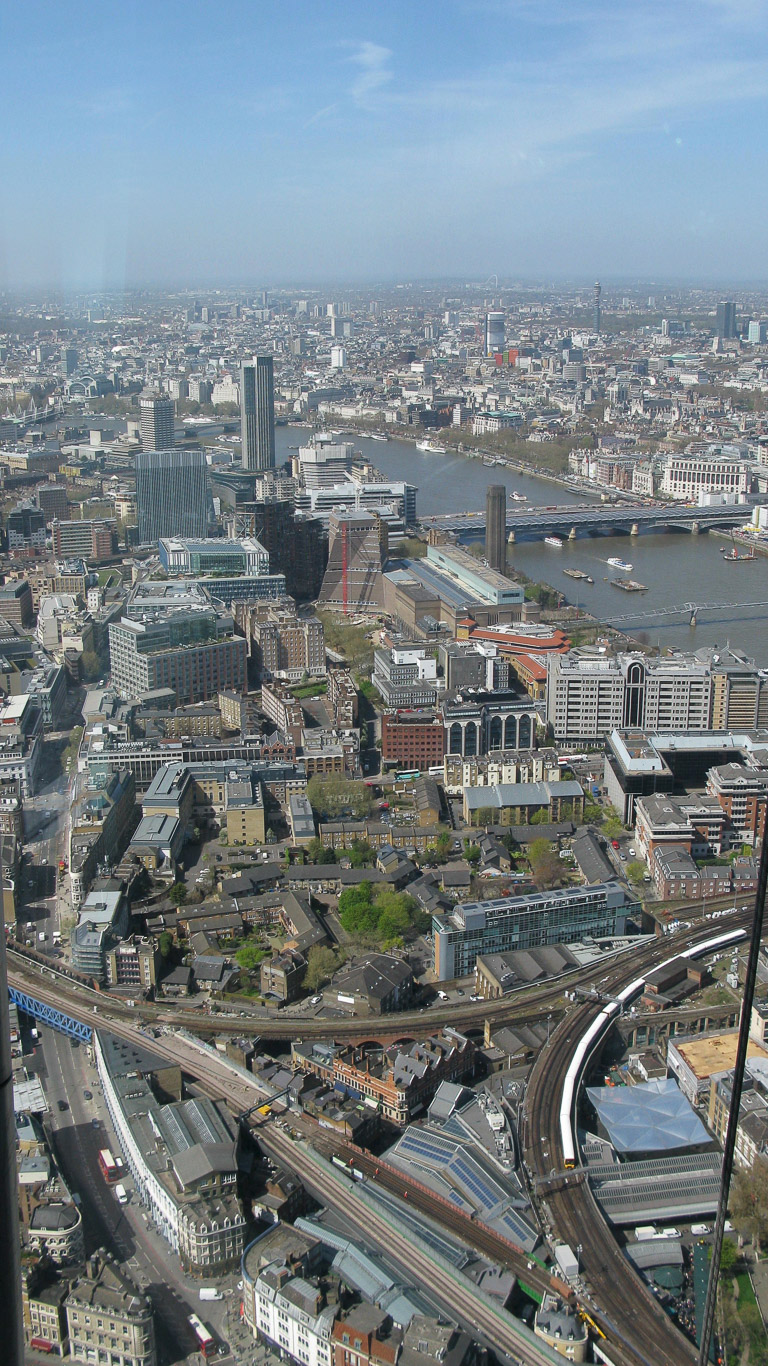
Tate Modern was opened in 2000 and is a modern art gallery in the former Bankside Power Station. It is easily recognisable with it’s turquoise blue band around the roof section of the building and its striking tall chimney in front. It stands on the bank of the River Thames and there’s a link to St Paul’s Cathedral opposite with the Millennium Bridge. It is Britain’s national gallery of international modern art and is one of the largest museums of modern and contemporary art in the world. It has been extended several times due to its success and more extensions are planned incorporating further parts of the original power station. The twisted looking building with the brick facade is also part of Tate Modern. It is known as The Switch House (and since 2017 has officially been renamed the Blavatnik Building after the benefactor Anglo-Ukranian billionaire Sir Leonard Blavatnik) and is a ten-storey tower built above the oil tanks creating various galleries. This building opened in 2016. The design of The Switch House has been controversial.
The railway tracks which rise above Borough Market have also been controversial because of the need to expand them in order to remove a major bottleneck in the national rail network and improve transport across London which has resulted in the destruction and alteration of a large number of listed buildings in the Borough Market area though the market continues to trade underneath the arches of the viaduct.
There are a number of bridges spanning the River Thames which you can see in the photograph above. The Millennium Bridge, officially known as the London Millennium Footbridge is a steel suspension bridge for pedestrians crossing the river linking Bankside and the City of London. First opened in 2000 it was soon closed as Londoners nicknamed the bridge the “Wobbly Bridge” because it swayed so much. Resulting in it remaining closed till 2002 while modifications were undertaken to eliminate the motion. The southern end of the bridge is near the Globe Theatre, the Bankside Gallery and Tate Modern, while the northern end of the bridge is next to the City of London School below St Paul’s Cathedral. The bridge has been designed so that a clear view of St Paul’s south facade is presented from across the river, framed by the bridge supports!
The next bridge upstream is Blackfriars Railway Bridge then Blackfriars Bridge for road traffic and pedestrians.
Finally in the above photograph you can just see the Hungerford Bridge and Golden Jubilee Bridges. The Hungerford Bridge (officially the Charing Cross Bridge) is a steel truss railway bridge which is flanked by two more recent, cable-stayed, pedestrian bridges that share the railway bridge’s foundation piers, and which are named the Golden Jubilee Bridges. The north end of the bridge is Charing Cross railway station and is near Embankment Pier and the Victoria Embankment. The south end is near Waterloo Station, County Hall, the Royal Festival Hall and the London Eye. It is this bridge that Jane and I later walk across having enjoyed the walk along the Thames from The Shard.
Now to look across the river . . . the brightly coloured buildings, covered with 134,000 glazed tiles in vivid shades of green, orange, lime and yellow, are part of Central Saint Giles, a mixed-use development in central London. The development consists of two buildings of up to 15 storeys in height, arranged around a public courtyard lined with shops and restaurants.
The tall slim tower on the right hand side of the photograph is the BT Tower. It is a communications tower located in Fitzrovia owned by BT Group. When it was completed in 1964 it became the tallest building in the UK a title it held until 1980 when it in turn was overtaken by the NatWest Tower (Tower 42).

Zooming in even more . . . In this close up you can really see how the railway lines dominate the area above Borough Market. The church, in fact it’s Southwark Cathedral or The Cathedral and Collegiate Church of St Saviour and St Mary Overle, is incongruously set against the busyness of the market and the office buildings close by. The Cathedral has been a place of Christian worship for more than 1,000 years, but it has only been a cathedral since the creation of the diocese of Southwark in 1905. The main railway viaduct connecting London Bridge to Blackfriars, Cannon Street and Charing Cross stations passes only eighteen metres from the southeast corner of the cathedral, blocking the view from the south side. This was a compromise when the railway was extended along this viaduct in 1852; the alternative was to demolish the building completely to allow a more direct passage for the line – which luckily they didn’t do!


This wide panorama looking west to north west gives us a view of more of more of the bridges crossing the River Thames and our first proper look at St Paul’s Cathedral. Let’s zoom in again and take a closer look . . .

The bridges now in view are the Canon Street Railway Bridge at the bottom of the photograph; then Southwark Bridge and the Millennium Bridge and finally Blackfriars Bridge. Across the river we can see St Paul’s Cathedral more clearly now.
St Paul’s Cathedral is an Anglican cathedral and the seat of the Bishop of London. It sits on Legate Hill at the highest point of the City of London and is a Grade II listed building. Its dedication to Paul the Apostle dates back to the original church on this site, founded in AD 604. The present cathedral, dating from the late 17th century, was designed in the English Baroque style by Sir Christopher Wren. Its construction was part of a major rebuilding programme in the City after the Great Fire of London since much of it had been destroyed by the fire. The cathedral is one of the most famous and most recognisable sights of London. It was the tallest building in London from 1710 to 1967. The dome is among the highest in the world. St. Paul’s is the second-largest church building in area in the UK after Liverpool Cathedral. Services held at St Paul’s have included the funerals of Admiral Nelson, the Duke of Wellington, Sir Winston Churchill and Baroness Thatcher; jubilee celebrations for Queen Victoria; peace services marking the end of the First and Second World Wars; the wedding of Prince Charles and Lady Diana Spencer; the launch of the Festival of Britain and the thanksgiving services for the Silver, Golden and Diamond Jubilees and the 80th and 90th birthdays of Queen Elizabeth II.
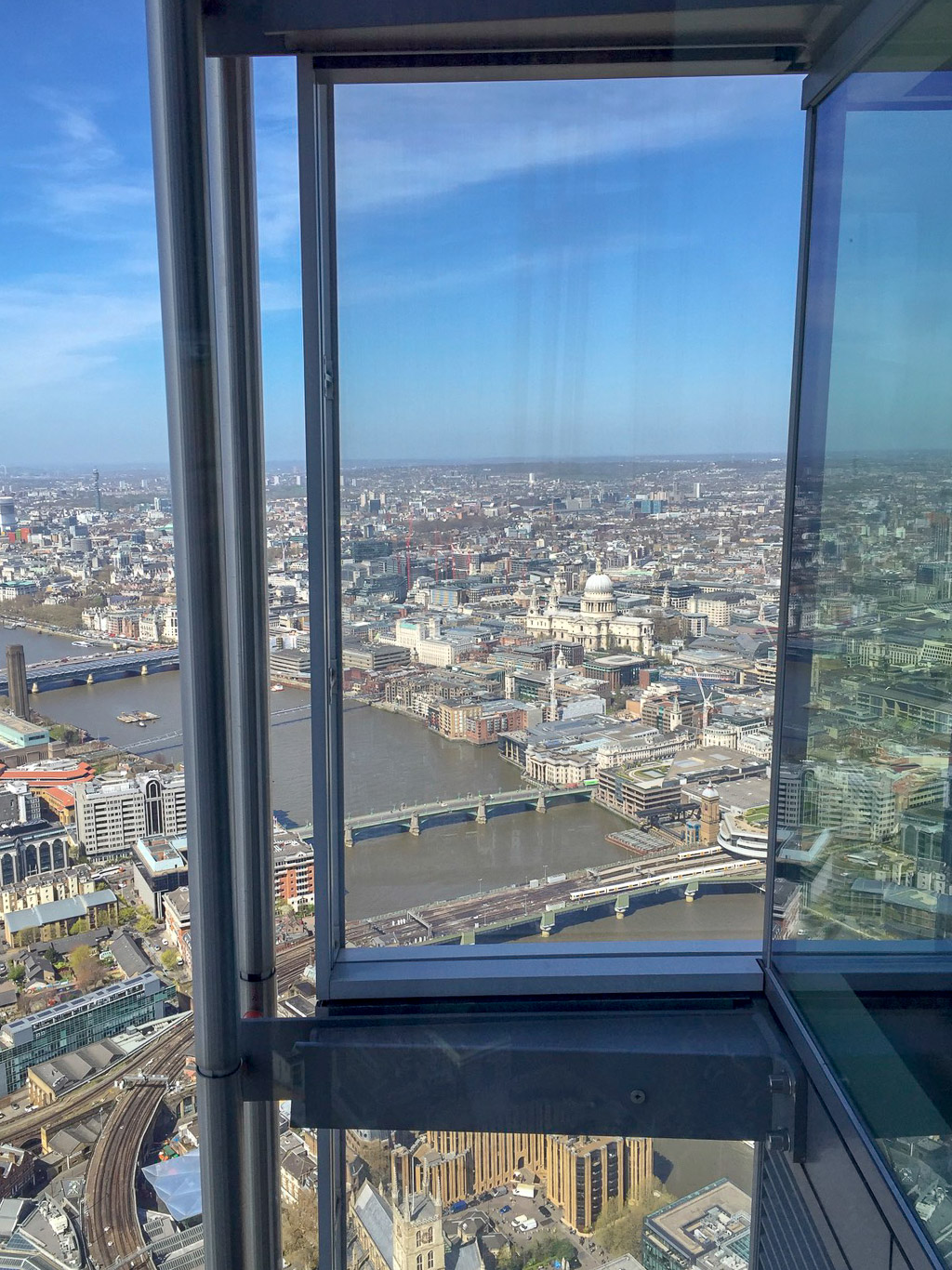
St Paul’s Cathedral ‘framed’ by the steel structures of The Shard.
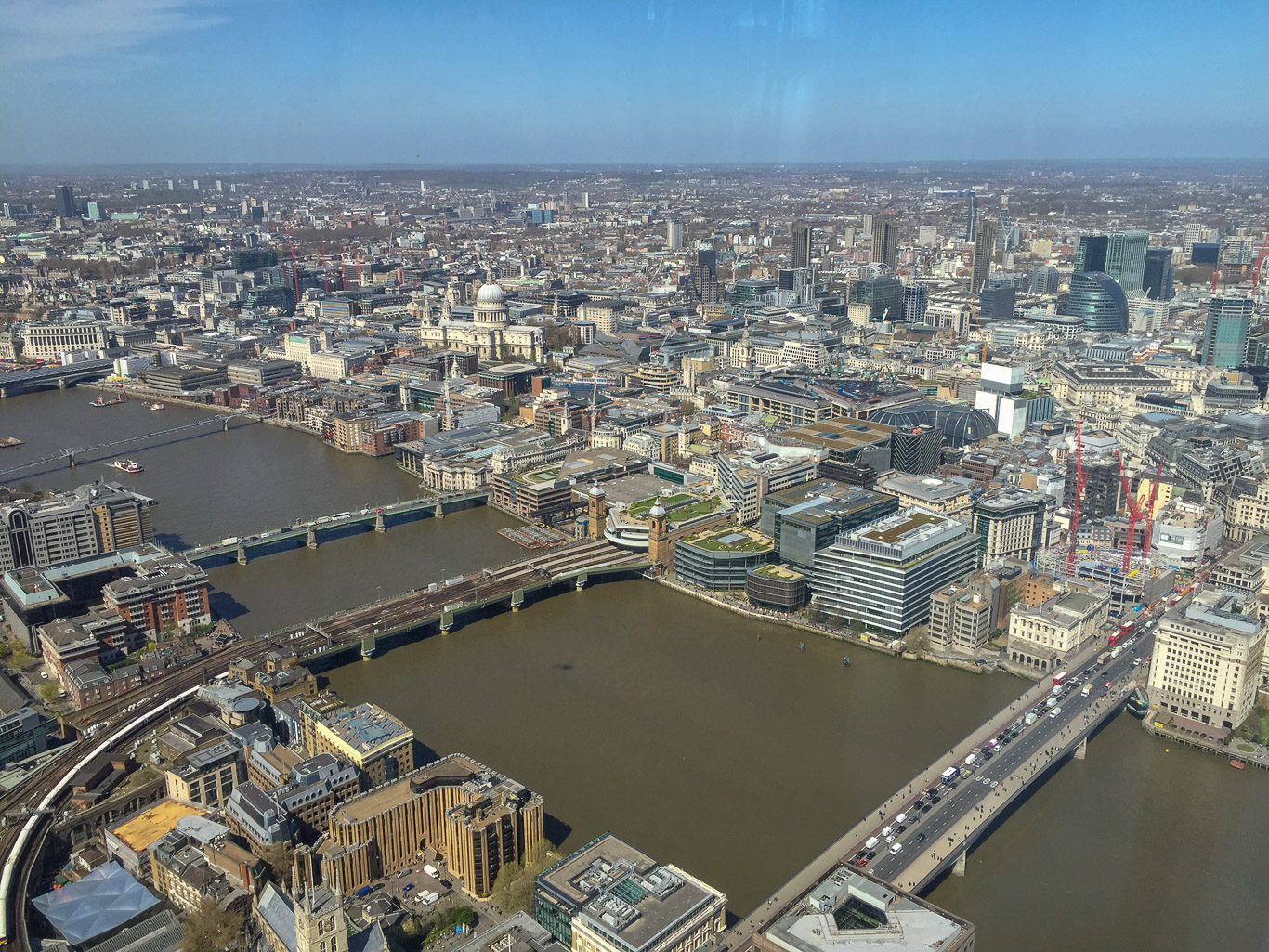
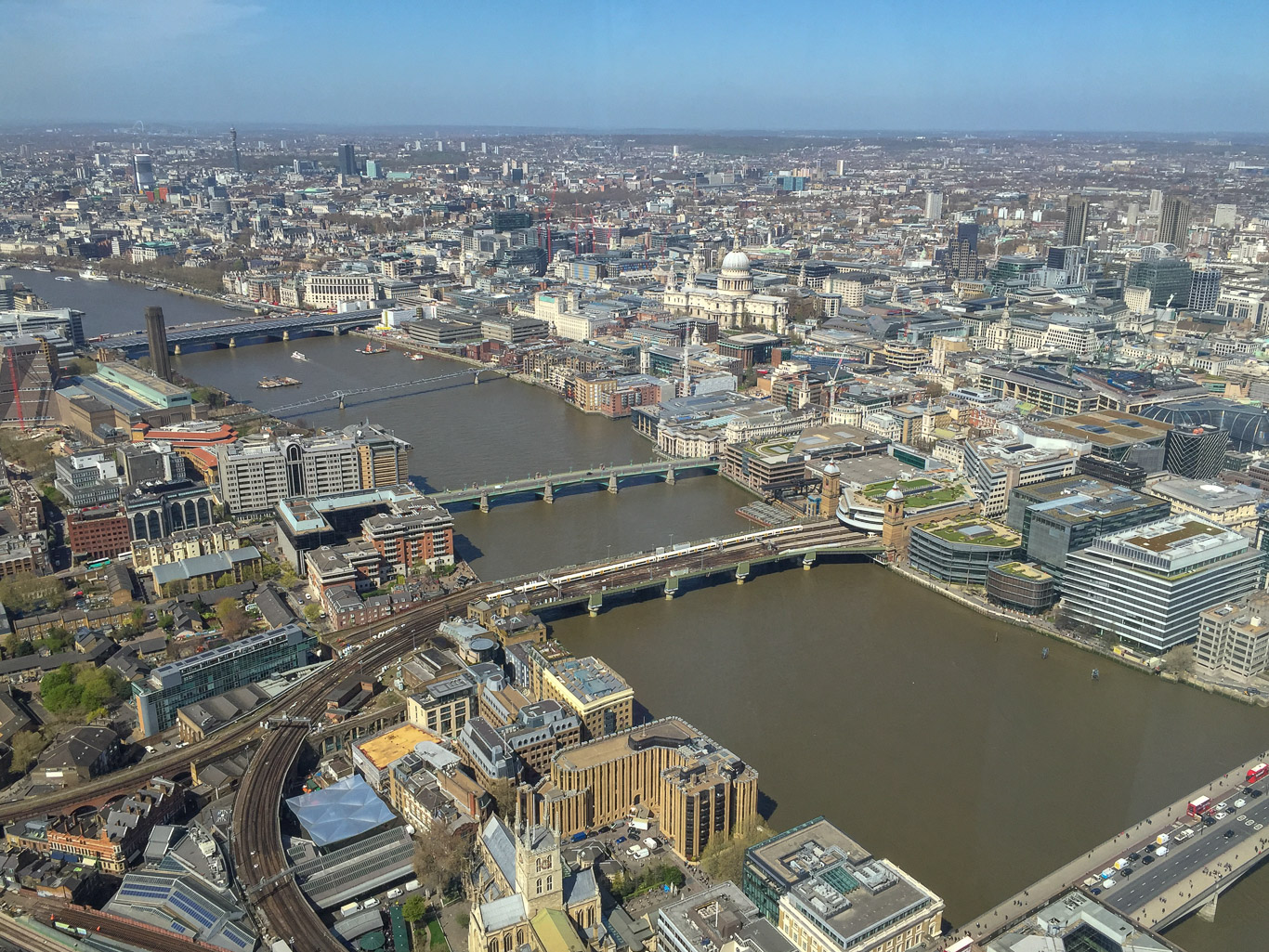
Some of the many bridges spanning the River Thames.
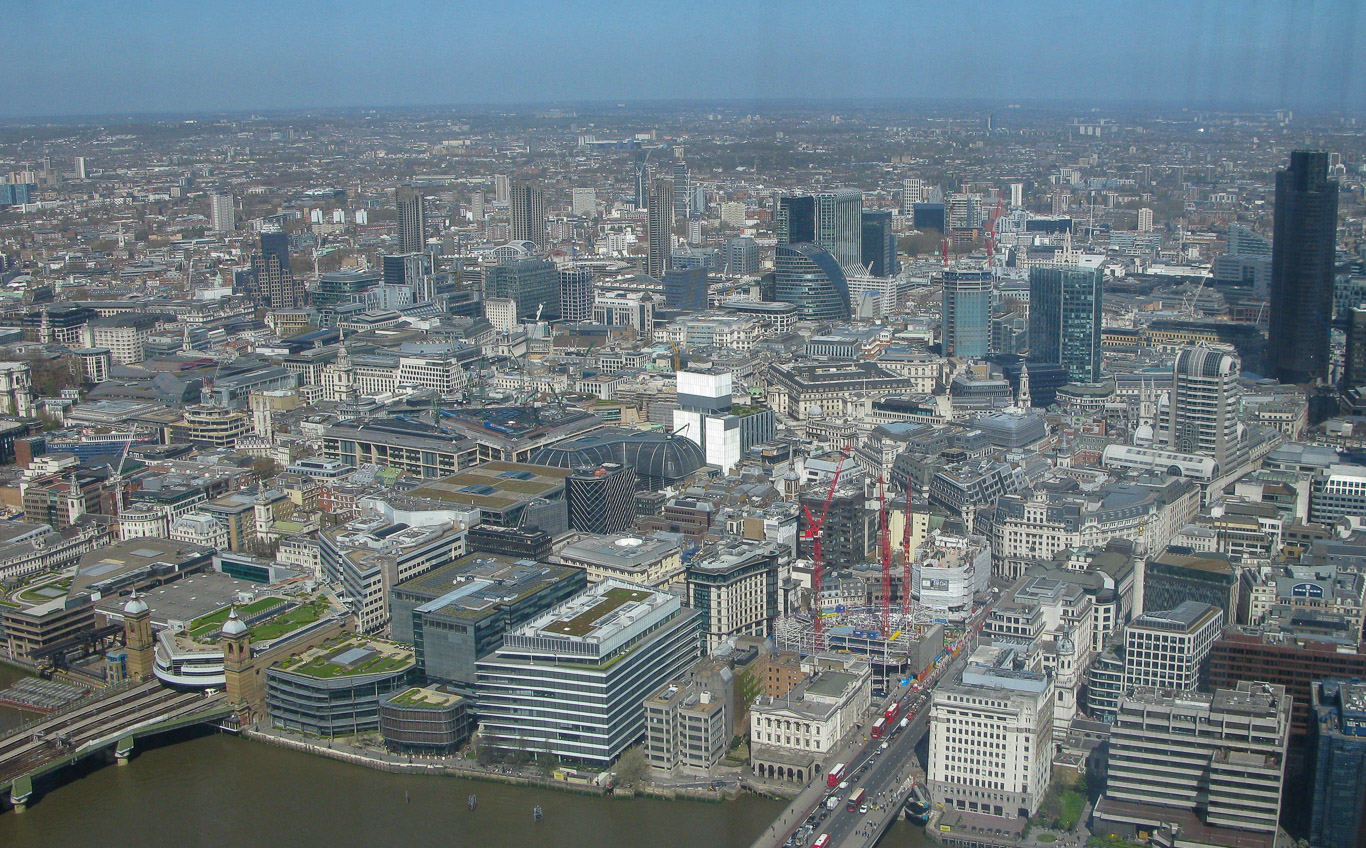
Further north the two bridges you can see are London Bridge with the red and white buses moving along it and Cannon Street Railway Bridge.
There have been a number of bridges called London Bridge – which may account for the popular nursery rhyme, ‘London Bridge is Falling Down’ and in its current form was opened in 1973. In 1967 London Bridge was bought by Robert p. McCulloch, the chairman of Mcculloch Oil Corporation and the founder of Lake Havasu City who had it dismantled and relocated to Arizona. He bought it as a tourist attraction for Lake Havasu, a large reservoir on the Colorado River – and it did in fact attract prospective buyers of land in the area which McCulloch had been given for free with a promise to develop the land. In the end McCulloch managed to recoup all his expenses on the purchase and shipping of the bridge though there is a popular rumour that the bridge was bought in the belief that it was London’s more recognisable Tower Bridge, but this was ardently denied by McCulloch himself and by Ivan Luckin, who sold the bridge! In 2017 London Bridge and Borough Market were the target of a terrorist attack and as a response security barriers have now been installed between the bridge’s pavement and road.
Cannon Street Railway Bridge comes in to Cannon Street Station – notice the roof top garden between the two towers. There were plans to build a helipad on top since there was a need for a heliport within 15 minutes drive of central London however it was thought that the noise from a heliport would disrupt City offices as well as services in nearby St Paul’s and Southwark Cathedrals, plus there were issues of ownership of Cannon Street and nearby buildings! The two towers at the front of the roof top garden are all that remain of the original station. The twin brick towers are Grade II listed and date back to 1866. The black building with with the chevrons is also part of the station. For such a small station, Cannon Street has had more than its fair share of accidents starting with a signalling error on Boxing Day 1867 which caused 10 injuries; then in 1914 a collision and subsequent derailment killed one person and another collision and derailment injured 12 people in 1961. More recently two people died and more than 500 were injured in 1991 when a train failed to stop as it pulled into the station. A similar accident had happened in 1919! If you’re wondering where the ‘cannons’ come into it – Cannon Street has nothing to do with religious canons, nor cannons of the weapon type. It is in fact a 17th century shortening of Candelwrichstrete – the street of the candle makers.
Beyond Cannon Street Station building with the bright white facade is the Rothschild Bank Headquarters. Rothschild and Co’s headquarters in London have been continuously located at New Court, St Swithin’s Lane, London for over two centuries.
Beyond Rothschild Headquarters is the square stone building with the dark roof, the Bank of England on Threadneedle Street. The Bank of England is the central bank of the UK and the model on which most modern central banks have been based. Established in 1694 (and based on Threadneedle Street since 1734) to act as the English Government’s banker it is still one of the bankers for the Government and is the world’s eighth-oldest bank. The Bank is one of eight banks authorised to issue banknotes in the UK. It is also the custodian to the official gold reserves of the UK and around 30 other countries. The vault, beneath the City of London, covers a floor space greater than that of the fourth-tallest building in the City, Tower 42, and needs keys that are three feet (91cm) long to open. As of April 2016, the bank held around 400,000 bars which is equivalent to 5,134 tonnes of gold. These gold deposits were estimated in August 2018 to have a current market value of approximately £200 billion. These estimates suggest that the vault could hold as much as 3% of the gold mined throughout human history!
Vintner’s Hall is the white building on the left hand side of London Bridge. The Worshipful Company of Vintners is one of the most ancient Livery Companies (London’s ancient and modern trade associations and guilds, almost all of which are styled the ‘Worshipful Company of . . . ) of the City of London, thought to date back to the 12th century. Vintners is part of the wine trade but one of the more peculiar rights of the Company involves the ceremony of ‘swan upping’ (an annual ceremony in England in which mute swans on the River Thames are rounded up, caught, ringed and then released.
On the right side of London Bridge three buildings back and to the right you can see the tall thin tower – The Monument to the Great Fire of London, more commonly known as the Monument which is a Grade II listed building commemorating the Great Fire of London. Its height (202 feet / 62m) is the same as the distance from the shop of Thomas Farriner, the King’s Baker in Pudding Lane where the Great Fire started on 2nd September 1666. Monument was constructed between 1671 and 1677 and was built on the site of St. Margaret’s Fish Street, the first church to be destroyed by the Great Fire. (Another monument, the Golden Boy of Pye Corner, marks the spot near Smithfield where the fire was stopped).
The Monument is a fluted Doric column built of Portland stone topped with a gilded urn of fire. It was designed by Christopher Wren and Robert Hooke. There’s a viewing platform near the top of the Monument up a narrow winding staircase of 311 steps, Mila and I have gone up there, it’s well worth a visit. Interestingly Wren and Hooke built the monument to double-up as a scientific instrument. It has a central shaft meant for use as a zenith telescope and for use in gravity and pendulum experiments that connects to an underground laboratory for observers to work (accessible through a hatch in the floor of the present-day ticket booth). Vibrations from heavy traffic on Fish Street Hill unfortunately rendered the experimental conditions unsuitable. At the top of the monument, a hinged lid in the urn covers the opening to the shaft. The steps in the shaft of the tower are all six inches high, allowing them to be used for barometric pressure studies. During the 2007-2009 refurbishment, a 360 degree panoramic camera was installed on top of the Monument. Updated every minute and running 24 hours a day, it provides a record of weather, building and ground activity in the City.

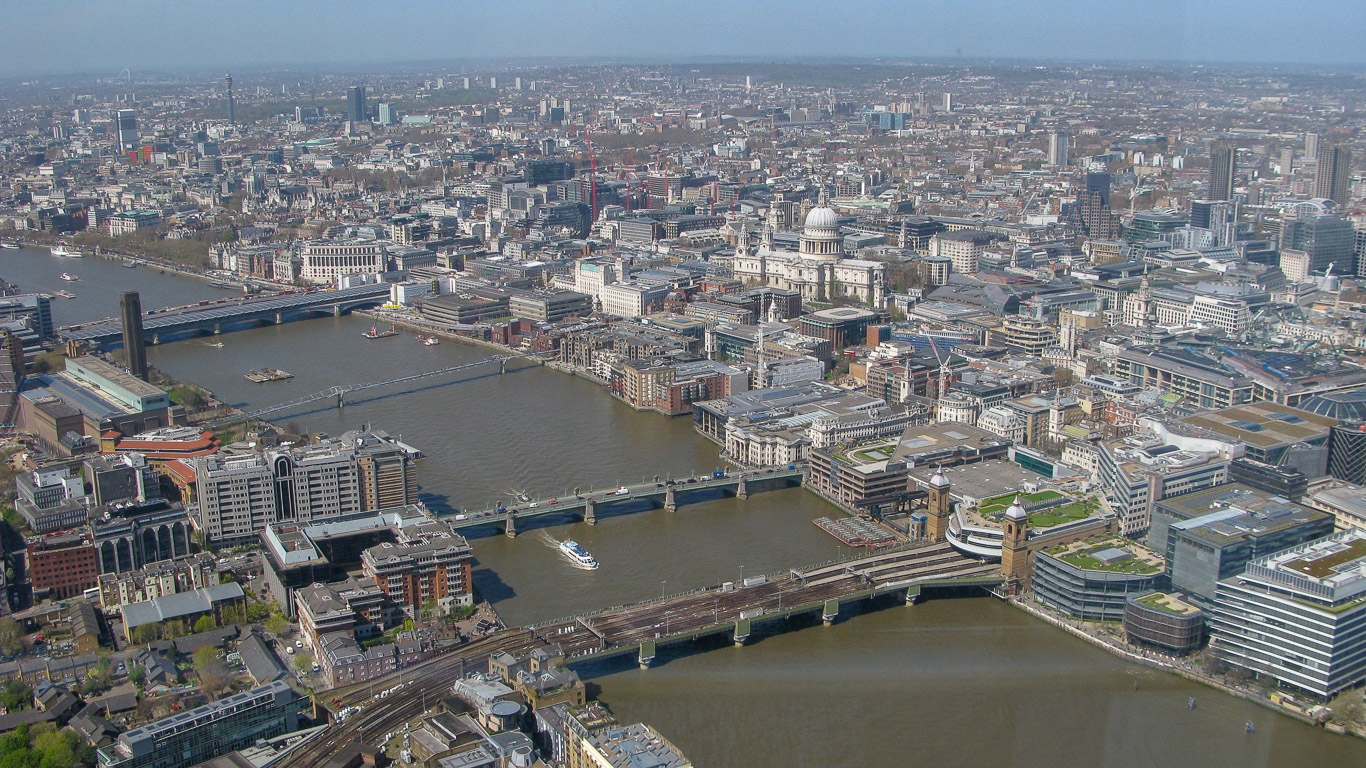

A panorama of the view . . . and what an impressive view . . . I don’t think we could have better weather than we’re getting today and it’s only April!

Which finally brings us back to our starting point, there’s London Bridge and the Walkie Talkie Building – 20 Fenchurch Street . . .


Having totally enjoyed the views it’s time to enjoy the rest of the day in the ‘big smoke’! London at its best!

Enjoying the sunshine as we walk along by the Southbank Centre.

A close up of The London Eye in the background as we walk along the river past the Royal Festival Hall.

We walked along the river past the Grade I listed building, the Royal Festival Hall, opened in 1951, as part of the Festival of Britain. It’s a 2,900 seat concert hall within the Southbank Centre bringing back happy memories of Mila who incredibly played a solo piano piece there (Minuet in G major – J. S. Bach’s Notebook for Anna Magdalena Bach, Anonymous) when she was only five years old! The London Philharmonic Orchestra, the Philharmonic Orchestra and the Orchestra of the Age of Enlightenment are resident in the hall.

Here’s Jane crossing the Hungerford Bridge . . .
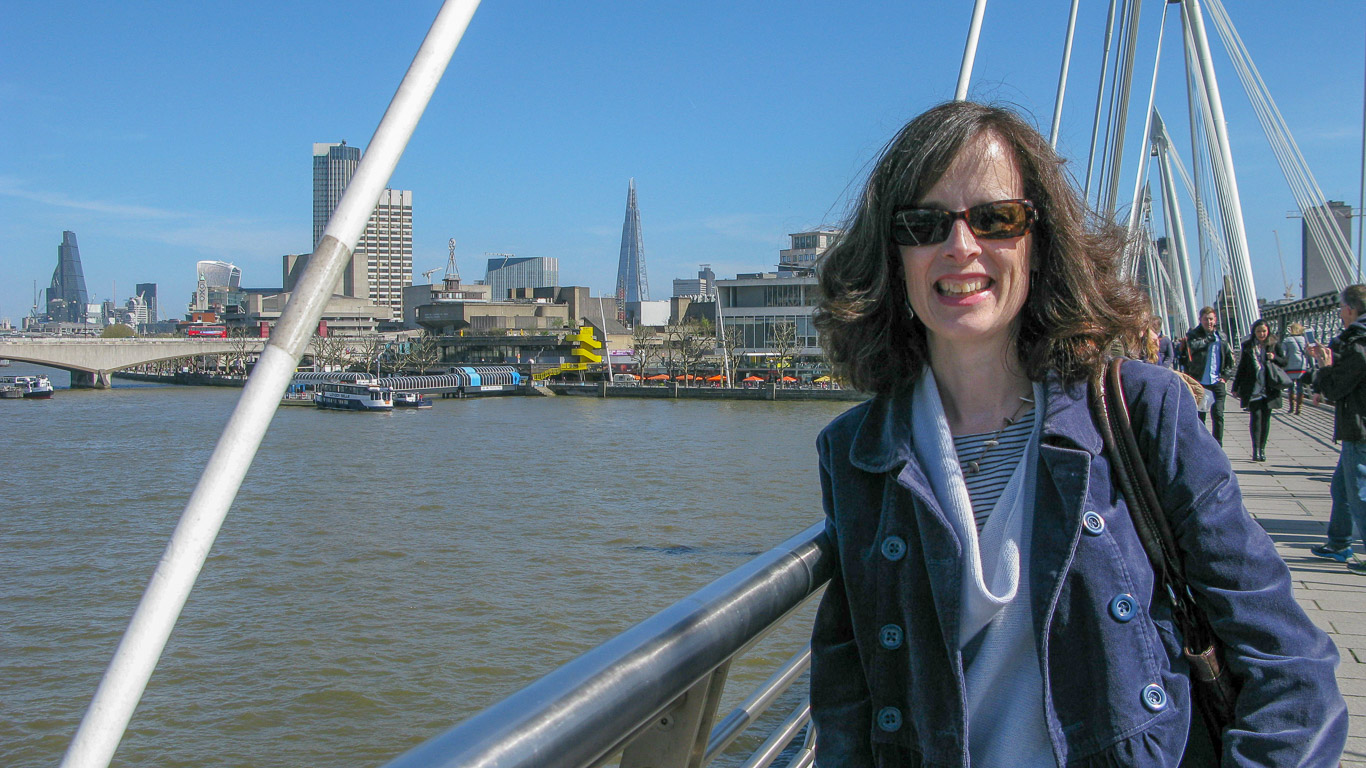
. . . and there’s one of me too! You can still see The Shard in the background! Then a walk through Piccadilly and Covent Garden and in no time we arrived at Brasserie Blanc in Charlotte Street, Fitzrovia (which has unfortunately since closed).
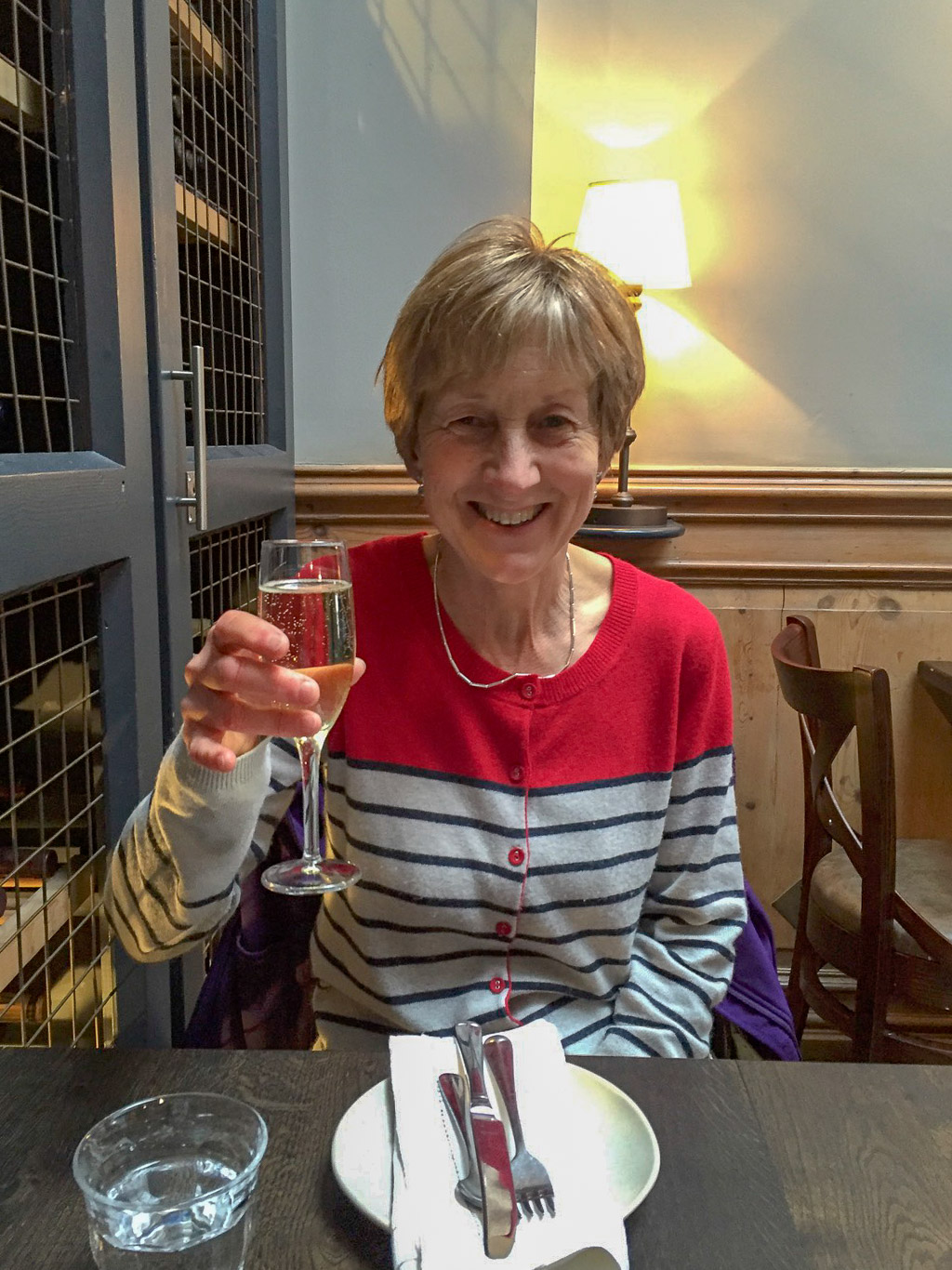
Cheers! Thanks to Jane we’re also having an amazing afternoon tea with, as you can see, a glass of sparkling French wine to go with it. The perfect was to round off our visit to London . . . it couldn’t have been a better day.

Raising a glass to Jane – a great friend and neighbour!
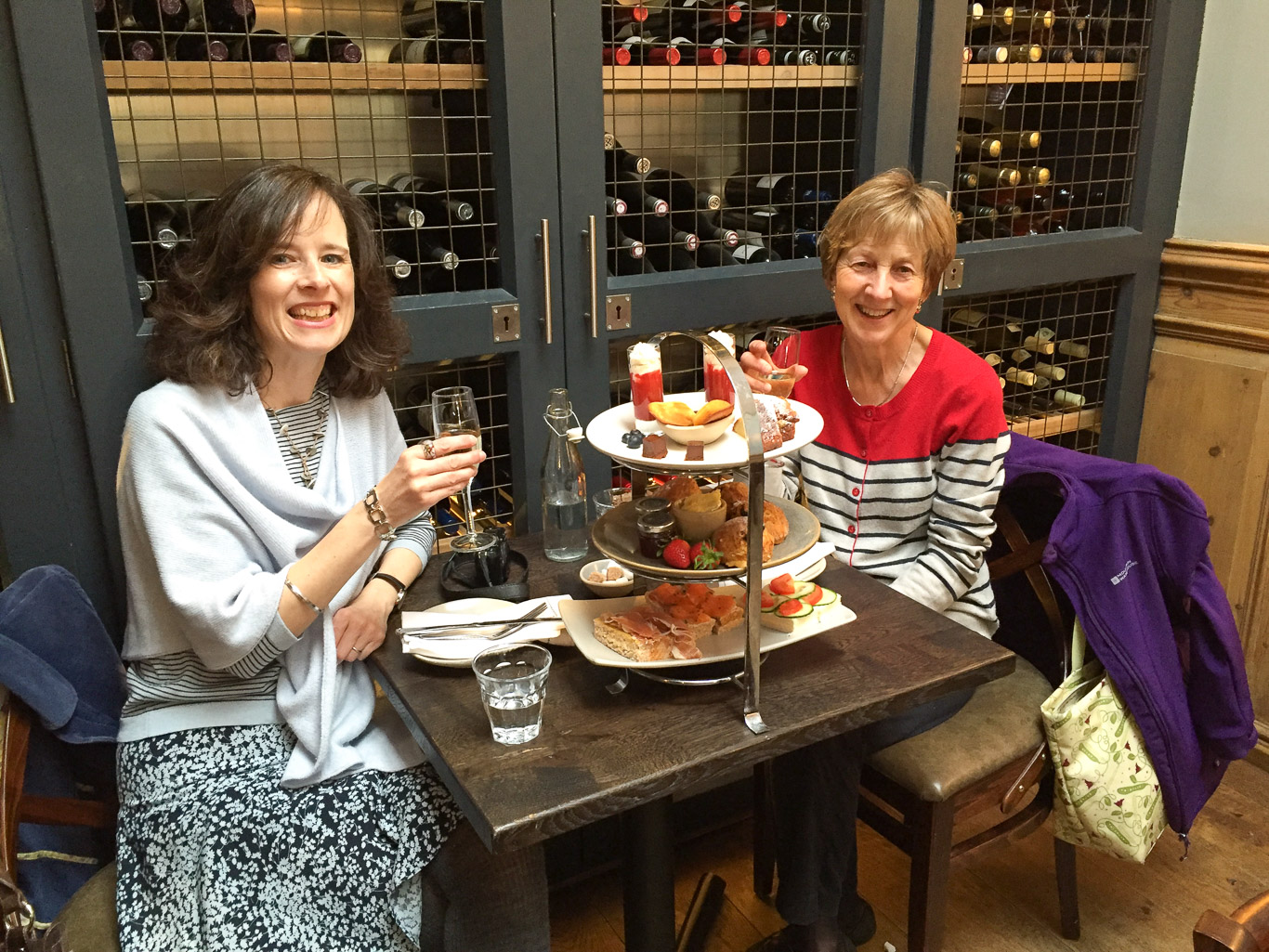
‘Chin chin!’ Time to enjoy our delicious finger sandwiches, scones and clotted cream and array of fancy deserts – yummy.
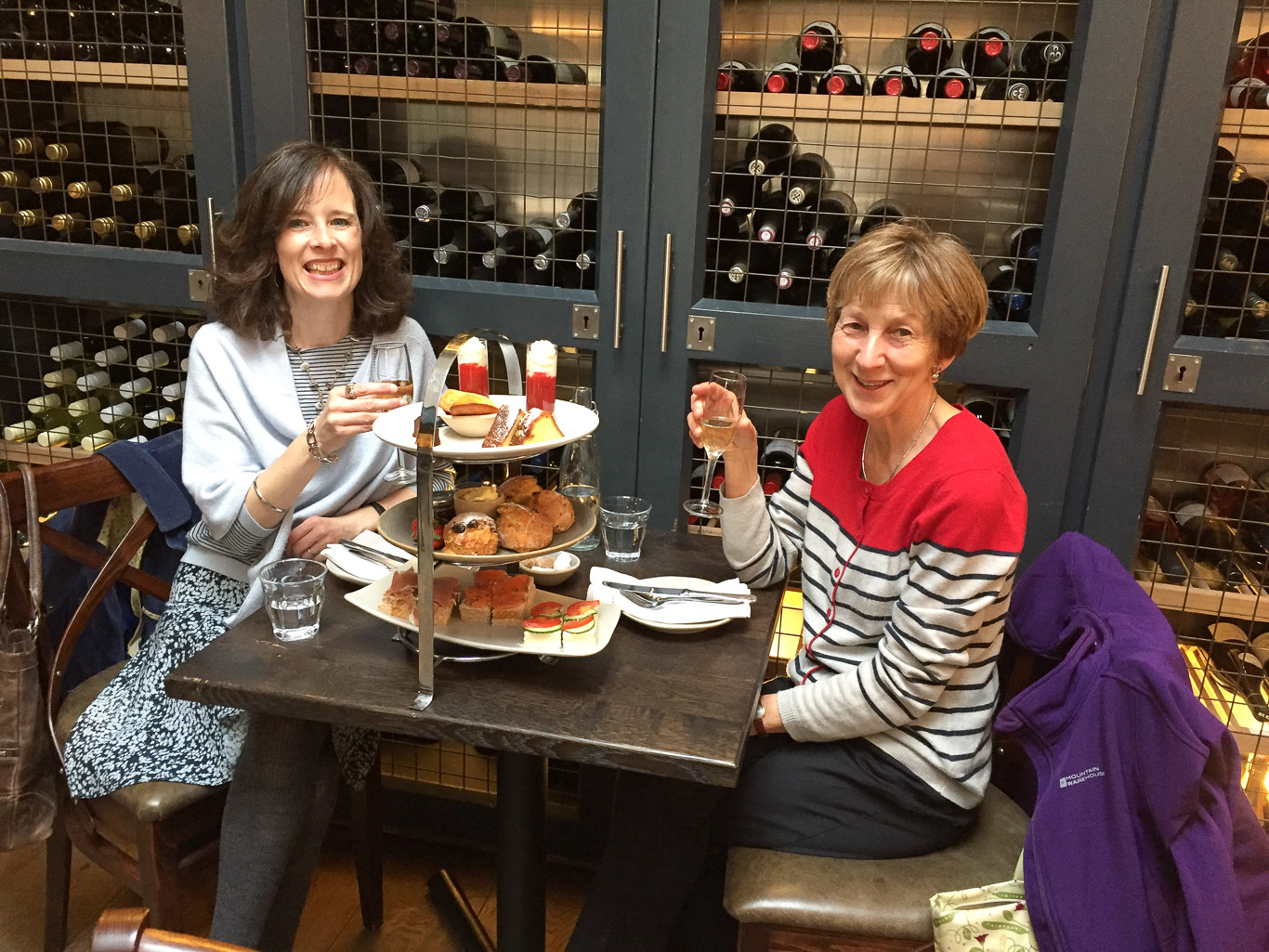
Thanks to the kind waitress serving us for taking this photograph of us both enjoying ourselves.

As you can see there was plenty to eat and all beautifully arranged.

Thank you very much Jane for sharing today with me!
Being such a glorious day we ended up walking everywhere determined to enjoy the sights of London rather than using the underground. We enjoyed walking so much that when we arrived back in Cambridge we decided to take the scenic route home taking in the tourist sights of Cambridge too!